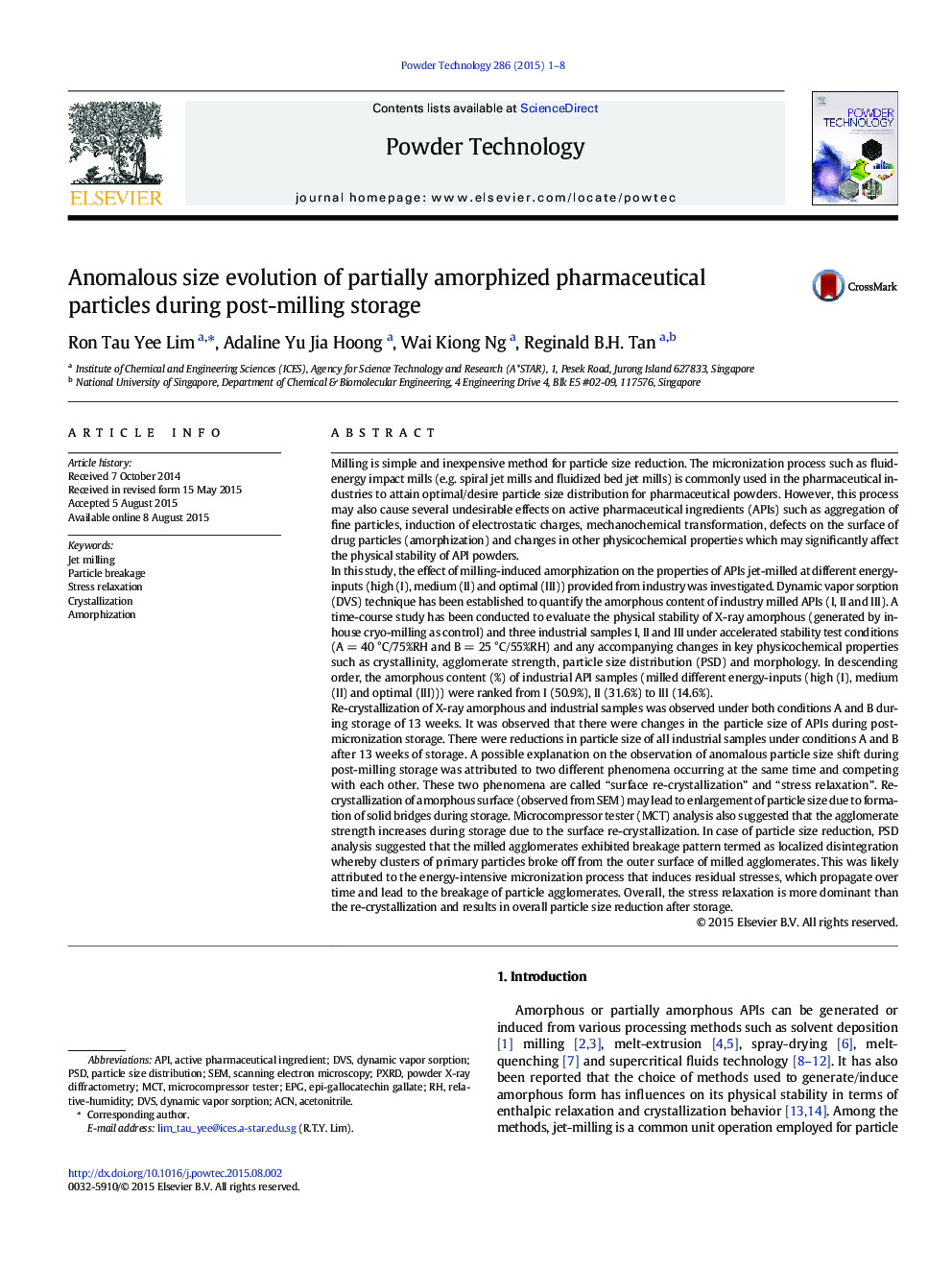| کد مقاله | کد نشریه | سال انتشار | مقاله انگلیسی | نسخه تمام متن |
|---|---|---|---|---|
| 235199 | 465631 | 2015 | 8 صفحه PDF | دانلود رایگان |
• Effect of milling-induced amorphization on API at various energy inputs was studied.
• Effect of humidity and temperature on X-ray amorphous and milled API was studied.
• Amorphous content of milled API was measured by dynamic vapor sorption method.
• PSD suggested the milled agglomerates exhibited localized disintegration.
• Particle size reduced after storage due to stress relaxation (dominant process).
Milling is simple and inexpensive method for particle size reduction. The micronization process such as fluid-energy impact mills (e.g. spiral jet mills and fluidized bed jet mills) is commonly used in the pharmaceutical industries to attain optimal/desire particle size distribution for pharmaceutical powders. However, this process may also cause several undesirable effects on active pharmaceutical ingredients (APIs) such as aggregation of fine particles, induction of electrostatic charges, mechanochemical transformation, defects on the surface of drug particles (amorphization) and changes in other physicochemical properties which may significantly affect the physical stability of API powders.In this study, the effect of milling-induced amorphization on the properties of APIs jet-milled at different energy-inputs (high (I), medium (II) and optimal (III)) provided from industry was investigated. Dynamic vapor sorption (DVS) technique has been established to quantify the amorphous content of industry milled APIs (I, II and III). A time-course study has been conducted to evaluate the physical stability of X-ray amorphous (generated by in-house cryo-milling as control) and three industrial samples I, II and III under accelerated stability test conditions (A = 40 °C/75%RH and B = 25 °C/55%RH) and any accompanying changes in key physicochemical properties such as crystallinity, agglomerate strength, particle size distribution (PSD) and morphology. In descending order, the amorphous content (%) of industrial API samples (milled different energy-inputs (high (I), medium (II) and optimal (III))) were ranked from I (50.9%), II (31.6%) to III (14.6%).Re-crystallization of X-ray amorphous and industrial samples was observed under both conditions A and B during storage of 13 weeks. It was observed that there were changes in the particle size of APIs during post-micronization storage. There were reductions in particle size of all industrial samples under conditions A and B after 13 weeks of storage. A possible explanation on the observation of anomalous particle size shift during post-milling storage was attributed to two different phenomena occurring at the same time and competing with each other. These two phenomena are called “surface re-crystallization” and “stress relaxation”. Re-crystallization of amorphous surface (observed from SEM) may lead to enlargement of particle size due to formation of solid bridges during storage. Microcompressor tester (MCT) analysis also suggested that the agglomerate strength increases during storage due to the surface re-crystallization. In case of particle size reduction, PSD analysis suggested that the milled agglomerates exhibited breakage pattern termed as localized disintegration whereby clusters of primary particles broke off from the outer surface of milled agglomerates. This was likely attributed to the energy-intensive micronization process that induces residual stresses, which propagate over time and lead to the breakage of particle agglomerates. Overall, the stress relaxation is more dominant than the re-crystallization and results in overall particle size reduction after storage.
Figure optionsDownload as PowerPoint slide
Journal: Powder Technology - Volume 286, December 2015, Pages 1–8
